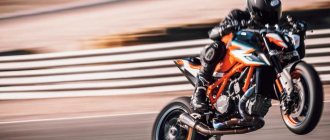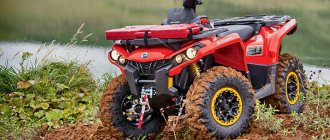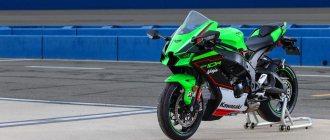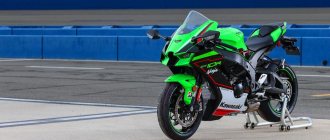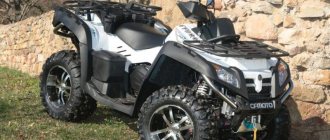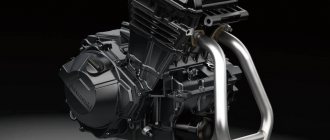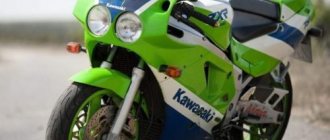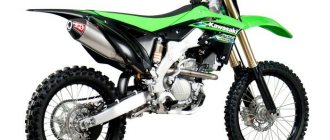You are walking down the street and suddenly hear a muffled roar. The sound grows and gets closer, and then a green motorcycle rushes past you at breakneck speed, flashing into your field of vision for a split second, literally flying over the road, shaking the surroundings with the roar of the engine and leaving a black trace of burnt rubber on the asphalt behind it. Impressive? Still would! Now imagine what emotions the person driving this plastic rocket, whose name is Kawasaki Z800, experiences at this moment?
The reference city bike for the most desperate motorcyclists
If a motorcycle is more than a utilitarian means of transportation for you, if you are partial to speed and the sensations it gives, if you love the best, then the Kawasaki Z800 is your choice. In this remarkable representative of the two-wheeled urban fauna, all the technological innovations of the Japanese concern, which is famous for its sportbikes, have found their application, and the designers gave it predatory and swift outlines, thanks to which the motorcycle in question immediately stands out in city traffic. The Z800, driven by a skilled biker, easily and naturally pierces the bustle of the city, standing out from the rest of the road users, like a shark among small fish.
Of course, such power imposes certain obligations and requires a very careful approach. There may be more powerful motorcycles in the world, but the Kawasaki Z800 technical characteristics allow it to develop breathtaking speed in a frighteningly short period of time. The Kawasaki Z750 replacement was launched in 2013 to break into the 800cc road bike scene from Suzuki and Yamaha, and is positioned as a powerful city bike for experienced riders. In addition, the forced engine of the Z800 has a very nervous character with pronounced dips and kicks, which can present an unpleasant surprise to an insufficiently experienced driver. No, it’s definitely not worth boarding this rocket without having solid experience behind you - it could end very badly. To curb the frantic nature of this representative of the Z-series, you will have to try hard.
Exterior of Kawasaki Z800
The first thing that catches your eye when you see the Kawasaki Z800 in person or in a photo is the absence of bulky plastic fairings . This is why motorcycle industry experts classify the Z800 as “naked” (naked). However, the bike is not 100% like that.
The role of wind protection is performed by a modest visor above the dashboard. The latter, paired with an angular front light, deserves special attention - it has a stylized appearance of a head, either an insect or an alien from outer space. The dashboard itself is very convenient and informative, although it is designed in a digital display format.
The exhaust pipes, which are deliberately accentuated and located under the engine block, also add brutality to the motorcycle. The exhaust pipe itself looks unusual, made in a mixed style of retro and futurism. The overall impression of the appearance of the Kawasaki Z800 is balance, aggressiveness and completeness of the image.
Characteristics and parameters
The main advantage of the 800cc streetfighter is undoubtedly its engine. A modern liquid-cooled inline-four produces 113 hp. and 83 nM of torque (although there is also a “strangled” modification - Z800E, with 95 hp of power and 76 nM of torque, respectively). The character of the Kawasaki engine is obvious - it only fully opens up at high revs, and when the tachometer needle crosses the 8000 rpm mark, the Kawasaki gets a second wind. There is a downside to this - in the lower rev range the bike reacts very sharply to the slightest turn of the throttle, which makes driving through city traffic jams somewhat difficult. Fortunately, the tenacious petal disc brakes are extremely effective in stopping a motorcycle that has accelerated, and the manufacturer also offers ABS as an additional option.
The combination of hurricane-force acceleration dynamics and grippy brakes is great, but the Kawasaki Z800's technical characteristics stand out from its competitors due to the fact that this bike is equipped with excellent suspensions. At the front there is a short-stroke inverted fork with adjustable preload and rebound, and at the rear there is a gas shock absorber from the renowned manufacturer Uni-Trak, adjustable for rebound and compression. In general, the Kawasaki suspension is quite stiff, that is, exactly what it should be on a motorcycle designed for aggressive riding - it does not prohibit sharp maneuvers and cornering with a knee. But it’s worth considering that in this mode, the Kawasaki Z800 will consume huge amounts of gasoline, despite the fact that during quiet driving it is very economical, and the 17-liter gas tank provides it with an excellent power reserve without refueling. But who rides calmly on a motorcycle that can accelerate to 100 km/h in 3.3 seconds?
The maximum speed of the Z800 is 230 km/h, but due to the lack of any sane wind protection, the headwind will begin to bother you much earlier - it causes discomfort already at 130-140 km/h. The seating position is quite classic, comfortable for most motorcyclists, regardless of their size. The seat is hard, but comfortable and not at all slippery. And in any case, we should not forget that this bike was created not for comfort, but for pleasure.
Is it worth buying a Kawasaki Z800?
The unusual Japanese “naked” is in that category of bikes in which there can be no outright mistakes in principle. The choice of one model or another comes down to studying the subject with a magnifying glass and taking into account the personal whims of the potential buyer. Among the most obvious advantages of the Kawasaki Z800 it is worth highlighting:
- aggressive exterior (can be considered a disadvantage depending on taste);
- powerful and reliable engine;
- high controllability and maneuverability;
- reasonable price;
- excellent acceleration dynamics.
Reviews from real owners
I bought a Z800 with 12 thousand miles, before that I drove a Yamaha FZ6 for two years and a Honda CB400 for a year. To be honest, after the first trip I got off the bike, put it in the garage and didn’t go near it for a week, because it really scared me. This is not a motorcycle, but a teleporter - you look somewhere, unscrew the right handle, and that’s it, you’re already there. Then I started driving, of course, but very carefully, and I felt like a first-season rider again. I’m completely immersed in it, the feeling the bike gives is simply indescribable, but it’s very difficult to ride it calmly, because it constantly provokes you. Sergey, St. Petersburg, Kawasaki Z800 '2014.
I read reviews on the forums about the Kawasaki Z800, decided that this was what I needed, and I was not mistaken. I sold my CBR F4i, added some money and took Cava. There are just a lot of sensations, after the CBR it’s like an airplane. The suspension is stiff, no matter how you set it, if you drive for a long time, the fifth point becomes numb. The seating position is comfortable. It’s also possible to travel long distances; when driving quietly, it consumes a little, the tank lasts 230-250 kilometers, but it’s boring to throw up like that, and you can’t take much luggage with you. Tuning on the Kawasaki Z800 is expensive, I hung plastic Chinese panniers on frames, but I’m afraid to drive quickly with them - as if the wind would blow them off. Ivan, Moscow, Kawasaki Z800 '2015.
After three years on the Zizer 400, I wanted something more powerful and something that looked more modern. The new 800 from the evergreen company came up just right, the Kawasaki Z800 has technical characteristics at the level, for the city it’s amazing for the eyes and ears, sometimes it’s even scary from what it’s capable of. I read a lot of reviews on the forums about the Kawasaki Z800 - at first I didn’t believe what the owners wrote about it. When I drove it myself, I realized that everything was true. The motorcycle is definitely not for a beginner; getting killed on it due to inexperience is a piece of cake. Not a bike, but a sports car, Formula 1 is resting. Valery, Istra, Kawasaki Z800 '2017.
Zetka pendant
The pendant is not too big so it doesn't fit
for the terrain, it's quite difficult for him. It may not look like a boat, but it feels even more uneven in the road. Sure, we have adjustability, and this bike could probably be made into a smooth daybed, but that's probably not the best idea. The motorcycle promotes fast, ambitious riding. This encourages swerving around corners. It's great to ride, so it costs a little stiffer suspension. Everything is fine in the city, so the route will not be worse. But as I already wrote: I will not ride on trails and beaten roads. Besides everything else, because this motorcycle...
Main competitors
- Yamaha FZ-8 . The Z-ki's most serious competitor, similar in price, although the Kawasaki Z800 has enough technical characteristics for a reasoned argument with it on the road. At the same time, the Yamaha has a much calmer and friendlier character, although, if necessary, it shows results that are not inferior to the Z800. The design of the FZ-8 is more classic, but also very decent. If the harshness of the Kawasaki is a negative factor for you when choosing a motorcycle, perhaps you will like the Yamaha better.
- Suzuki GSR 750, aka GSX S750 . If we compare it with analogues from Kawasaki and Yamaha, then the bike from Suzuki will be closer to the Phaser. Powerful and modern, it still doesn't have the explosive character that the Kawasaki Z800 can boast. At the same time, both in terms of dynamics and other parameters, this motorcycle can provide worthy competition to the two aforementioned rivals.
Specifications
| Maximum engine power: | 113 hp at 10200 rpm HP |
| Torque: | 83 Nm at 8000 rpm Nm |
| Working volume: | 806 cm3 |
| Motor type (cylinder arrangement, number of strokes): | In-line, 4 cylinders, 16 valves |
| Number of cylinders: | 4 |
| Number of valves: | |
| Intake type (Injector / Carburetor): | |
| Bore and stroke: | |
| Starting system (Electric starter, kick starter): | |
| Cooling system: | Liquid |
| Transmission (gearbox): | 6, Mechanical |
| Clutch (Dry / Wet): | |
| Drive unit: | Chain |
| Frame: | Steel spine |
| Chassis | |
| Suspension (front/rear travel): | |
| Brakes (Front/Rear): | |
| Wheels / Tires / Rubber: | |
| Dimensions and weight | |
| Dimensions (Length / Width): | |
| Seat height: | |
| Ground clearance: | |
| Curb weight: | |
| Wheelbase: | 1445 mm |
| Weight: | 229 kg |
| Fuel tank capacity: | 17 l. |
| Battery capacity: | |
| Year of release: | |
| Country of Origin: |
Peculiarities
The first thing that attracts attention is management.
Steering the bike is very comfortable; this is facilitated by the wide handlebars, the proportions, and the classic vertical landing . In addition, the motorcycle is stable and has a smooth ride. The brakes are also excellent, the front disc does its job fully, and in severe cases it is helped by the rear drum.
The main feature of the “eight hundred” is its engine. The operating figures are almost identical to those of the 650, but at the same time the engine is much more torquey and quieter, and has lower operating and maximum speeds. In other words, at medium and low speeds it will “pull” well even in high gears.
The design is also top-notch – a ribbed saddle, wheels with thick spokes, a lowered steering wheel, and exhaust trims. All parts are either chromed or lacquered, which, combined with the restrained color scheme and overall layout, creates the impression of a real British retro of the mid-20th century.
The instrument panel combines classic and modern: an analogue tachometer and speedometer are adjacent to an LCD screen displaying the tripmeter, clock and odometer. Also on the panel are “flashing lights” for turns and neutral, and an oil indicator.
Review of Irbis Garpia 250
Judging by the photo, the Irbis Harpy 250 motorcycle can be safely classified as a road bike that can be used both for long trips on the highway and within the city. This model is unique in its category of road bikes, since it was originally created in a classic brutal style, which is emphasized not only by its modern, appropriate design, but also by its considerable weight of 146 kilograms.
“Irbis Harpy 250” is distinguished not only by its low cost, but also by its good technical characteristics. The motorcycle is equipped with a reliable oil cooler, and the suspension is made in a classic style. The muffler of the bike is non-standard, thanks to which the Irbis Harpy differs favorably from its competitors: this part has an additional end through which accumulated exhaust and excess moisture are removed. Considering all the above characteristics, the Irbis is truly a unique motorcycle.
Brakes in Zetka
I won't say a bad word about the brakes. ABS is standard, but it works really well. No jerking is felt when turning on. His work was more accompanied by the gentle “flow” of the wheel at the limit of loss of traction. On a wet road with a little mud on a poor standard non-insulated tire, the motorcycle gradually lost speed. Not once did the wheel lock for a moment, but it was already flowing at the locking/sliding border. There were no problems on dry ground. Definitely better than the Z650. For everyday use, it is enough to use the handle with one finger, and a slight deceleration is felt.
Kawasaki Z900Dashboard
The ergonomics of the motorcycle in question remains at the highest level, in the traditions of the old Japanese school, which assumes the presence of elements and parts in the most accessible and convenient places. Excellent seating position is ensured by good contact with the seat, as well as a fairly high and wide handlebar. The configuration of the tank allows it to harmoniously merge with the seat into one whole, guaranteeing comfort on long trips.
The fact that the Kawasaki Z-800 is a worthwhile motorcycle is further evidenced by an informative dashboard with wide functionality. In addition to the basic parameters, the driver receives information about fuel consumption and the possible distance that can be covered with the remainder. The center of the instrument panel resembles a device from science fiction films and is equipped with a liquid crystal tachometer. As the speed increases, the stripes become larger in size, which ensures their excellent visibility. Fans of the standard pointer dial will have to get used to the innovation for some time.
About the Japanese motorcycle industry in general
There are several objective reasons why Japanese motorcycle manufacturing is considered the best:
- In Japan, motorcycles are not a whim, but an ordinary vehicle, the use of which is justified by its efficiency.
- Everyone knows Japanese hard work and responsibility, and this cannot but affect the quality of products.
- In the global market, Japan relies on high technology, so equipment produced in this country is distinguished by the use of the most advanced developments.
All three of the above reasons come down to one thing: Japan is an island state with harsh living conditions and few resources. This forces residents to develop professionally in conditions of fierce competition.
It is noteworthy that when the motor industry first began in Japan (immediately after the Second World War), their equipment had a reputation for being second-rate. Motorcycles and motorbikes were created as budget vehicles, and therefore did not initially claim an exorbitant level of quality.
First Honda motorcycle
Over time, the situation has changed - Japanese motorcycle brands have become a guarantor of quality for the whole world.
It is generally accepted that the four main Japanese motorcycle manufacturers are the brands Yamaha, Honda, Kawasaki and Suzuki.
Honda
The company was founded in 1948, and since 1982 it has produced more than 3 million motorcycles annually. By 1973, the company was already considered one of the most popular manufacturers in its field. With such an early start, compared to Suzuki, Kawasaki and Yamaha, Honda gained worldwide fame later than everyone else.
In addition to motorcycles, Honda also produces cars, ATVs and power equipment.
The author of this brand is the most popular cruiser motorcycle - Honda Gold Wing.
In the seat of the Honda Gold Wing cruiser you feel like on a royal throne
This model is ideal for long motorcycle trips - a spacious (by motorcycle standards) trunk allows you to take everything you need with you, and a comfortable seat creates comfortable conditions for the driver and passenger
This is important when you need to drive 1000 km without a break.
Gold Wing provides comfortable seats for the passenger and driver
This motorcycle may seem slow and clumsy. In fact, this is not the case - the model is capable of reaching speeds of up to 200 km/h, which is more than some sportbikes.
It is noteworthy that there are worldwide fan clubs dedicated to this model, in which motorcyclists share their experiences of traveling and servicing their favorite motorcycle.
Motorcycle for travel
Most motorcyclists buy the Harpy for long trips. A bike for such trips should be as comfortable and reliable as possible. All the shortcomings that similar models suffer from were taken into account by the manufacturer, who tried to create a comfortable motorcycle. On long journeys, the main thing is the seat, which in the Harpy is made of soft materials. The bike is equipped with a wide handlebar and footpegs. A separate seat with a small backrest allows you to take a passenger on a long journey.
The Irbis dashboard contains various indicators that allow you to monitor the condition of the motorcycle during the trip and fully control the movement.


